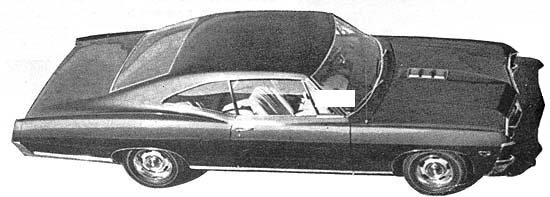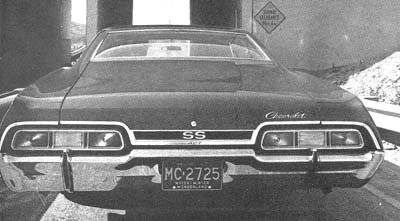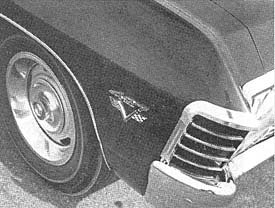

| NOT SO MANY years ago a motorist shopping for one of the "low-priced three" knew that no matter which make and model he elected to buy, he would drive home a car instantly recognizable as basic, no-frills transportation. His neighbors were aware that here was a man who was putting practicality ahead of ostentation, that this was a man who demanded - and got - a means of transport at minimum cost. If his thinking was reasonably advanced he probably included a heater, and if he was especially daring, he may have ordered a true luxury accessory - a radio. |
| For better or worse, that era is gone, and the fact that it's not coming back soon was brought forcefully home while testing the Impala SS 427. Here is a Chevrolet with the most advanced mobile creature comforts currently available in combination with performance which was, until very recently, reserved for dragstrip specials. It may well be the ultimate average car - the status symbol for Everyman - at least for the duration of 1967. What really made the package significant was the pricetag, erasing forever the image of Chevrolet as a member of the low-priced three. With transportation (West Coast), license and local sales tax, it was substantially more than $5000. It would have been possible to raise the price another couple of hundred by putting on a few additional accessories - perhaps power windows and seats would have been in keeping with this car's character - but even without them CL's SS 427 was what salesmen term "loaded." |  |
| Is a Chevrolet worth $5000? The answer, it seems is integral to evaluating the car in terms of what it does and who is likely to be attracted to it. Lest CL be accused of an approach which says that the only good car is a practical car, this just isn't so. CAR LIFE liked the Impala. Ride was good, handling fair to good, braking barely passable, and the acceleration/speed exciting. Turn on the air conditioning, tune in the FM multiplex stereo (or, if out of FM range, push in a tape cartridge and listen to Lorne Greene narrate "Songs of America"), and the sensation is pure luxury - the approximate equivalent of the most expensive automobiles available. Note the qualifying word "approximate"; no production Chevrolet ever will match the richness and fine detailing inherent in cars where base pricing starts $1000 - above the Impala's delivered price |
| THE SS 427's most impressive feature, logically, is the 427 engine. At 385 bhp, the configuration is new this year. Coupled with a Turbo Hydra-Matic, also new for Chevrolet in 1967, and Positraction differential, the engine stands at the head of a formidable power train. Granted, it falls into the heavy blunt instrument class, but forward progress starts immediately. During acceleration runs, the biggest problem was controlling rear wheelspin from a dead stop. The engine seemed willing to rev well past its published limits. There was an orange segment on the tachometer at 5200-5500 rpm; the automatic was shifted L-1, L-2, D within this range. Drivers were careful to avoid the red, which started at 5500, for two reasons: No one wanted to risk breaking the engine, and the bhp peak is at 5200, so it was fruitless to press much past that point. |

|
Chevrolet offers a heavy-duty 3-speed manual transmission and a 4-speed with the 427 engine. Certainly some of the sporting types will opt for the 4-speed box simply because there remain those who enjoy shifting. As a practical matter, the Turbo Hydra-Matic is an excellent choice, |
| offering good control and smooth shifting. In drive range, maximum upshift point 1 to 2 is 59 mph, 2 to 3 is 99. Kickdown speeds are 46 and 93. It has a suggested list price of $226.45, compared with the 4-speed's $184.35, and the heavy-duty, synchronized 3-speed at $79.
While the showroom-stock quarter-mile times were reasonably impressive, this is the kind of car in which acceleration could have been improved with minor alterations. For one thing, tires with more bite would have cut elapsed time and improved the speed. The SS 427 package calls for Nylon red stripe tires, but for some reason CL's test car did not have them. And Superlift or equivalent shock absorbers would have aided in delivery of power to the ground. Indeed, an extra 6-8 mph are available without touching the engine or exhaust system. The optional performance axle ratio, 3.31:1, also would prove an asset. One thing the engine doesn't offer in abundance is economy, although an economy axle ratio, 2.73:1, is listed. Parsimony shouldn't be expected from 427 cu. in. Around town the 427 drinks super-premium fuel at about 10 mpg, improving slightly on the open road. However, the type of motorist who selects a 427 engine shouldn't be concerned with fuel mileage, except to have a general idea of how far he can go without running out of gasoline - on the average, 287 miles. |
| ONLY the SS and 427 medallions say this car differs from run-of-the-mill Impala family sedans. Price, appointments and appearance, however, put this particular Impala in the luxury car class. | 
|
| IN SPITE OF M. Bugatti's low opinion
of the importance of brakes ("I build cars to go, not to stop"), most people like to stop safely and quickly every time they apply pressure to the brake pedal. On this point the SS 427 is deficient. CL's standard 80-mph maximum deceleration stops revealed two things; rear wheel lock-up and significant fade. The latter was quite pronounced on the second stop. The option book reveals a $79 cure -- front wheel disc brakes, which are part of a package that includes 15-in. wheels. The fact is, normal, low-effort stopping is quite good, so deceptively good that a driver would surely be unaware of the problems revealed instantly in a high-speed panic stop. A lesser option that should prove helpful is sintered-metallic brake linings, priced at $36.90.
Up front, the Strato-Bucket seats are comfortable-firm and with reasonably good support for back and thighs. There were headrests in the test car, and frankly they appeared more decorative than functional. They are adjustable upward, but their flush position in relation to the seat plane makes them more suitable as whiplash, protective devices than as something designed for passenger relaxation. An infinitely adjustable seat recliner would have been a welcome addition that could have made the headrests of genuine value for a passenger, and would have given the driver a welcome change of position. |